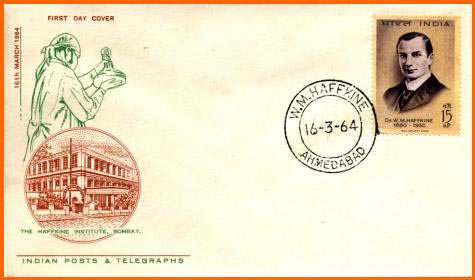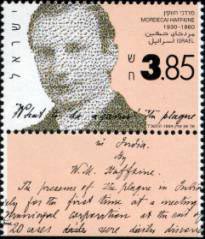Dr. Waldemar Mordechai Haffkine AKA Vladimir Aronovich Khavkin (1860 - 1930)
Born: March 15, 1860, Odessa, Russia.
Died: October 20, 1930, Lausanne, Geneva.
Vladimir Khavkin (the name he was known by in Russia) was a son of a Jewish schoolmaster, Aron Khavkin. He was born in the prosperous Black Sea port of Odessa, but received most of his early education in Berdiansk. He graduated from local Gymnasium (classic high school) in 1879. After the school he enrolled to the Department of Natural Sciences in Odessa Malorossiysky University and studied physics, mathematics and zoology. While in the University, Haffkine came under the influence of Elie Metchnikoff, the microbiologist and future Nobel Prize winner. At the same time in an effort to combat open anti-Semitism he became active in the Odessa Jewish self-defense league. As a result he was arrested by the Russian authorities, but was released after Metchnikoff’s intervention.

The research center that in 1925 was named Haffkine institute on the cachet of Indian FDC as well as India's commemorative stamp.
Haffkine completed his studies in 1883 with a degree in Natural Sciences and joined the staff of the Zoological Museum in Odessa. Despite his early scientific accomplishments, he was denied a teaching position, for refusing to be baptized. He left for Switzerland in 1888 and worked as an assistant at the Geneva medical school for a year.
In 1889 he moved to Paris and started working in Pasteur's world famous laboratory where already worked Elia Metchnikoff. His initial work on producing a cholera inoculation was successful. He produced an attenuated form of the bacterium by exposing it to blasts of hot air. A series of animal trials confirmed the efficacy of the inoculation.
In July 1892, Haffkine performed his first human test: on himself! During the Indian cholera epidemic of 1893, he traveled to Calcutta and introduced his new prophylactic inoculation. After initial criticism by the local medical bodies, it was widely accepted.
At the outbreak of the plague epidemic in Bombay in October 1896, Haffkine was summoned to the city. He improvised a laboratory in the Grant Medical College and set to work on preventive and curative measures. A curative serum was tested in four months, but was not found to be reliable. Emphasis moved to a preventive vaccine using dead bacteria. A form useful enough for human trials was ready by January 1897, and tested on volunteers at the Byculla jail the next month. Use of the vaccine in the field started immediately.
Recognition followed quickly. The Aga Khan provided a building to house Haffkine's "Plague Research Laboratory" and other prominent citizens of Bombay supported his researches.

You may see the title and first lines of Haffkine manuscript “What to do against the plague in India” on Israeli stamp issued to honor the scientist in 1994.
However, the medical community was not very sympathetic towards him. In 1902 the vaccine apparently caused nineteen cases of tetanus. An inquiry commission indicted Haffkine, who was relieved of the position of the Director of the Plague Laboratory. A review of this commission's report by the Lister Institute in England overturned this decision, put the blame squarely on the doctor who administered the injections, and exonerated Haffkine. Since the Bombay post was already occupied, Haffkine moved to Calcutta, where he worked until his retirement in 1914. Then he returned to France and settled in Boulogne-sur-Seine, and occasionally wrote for medical journals.
In 1925, when the Plague Laboratory in Bombay was renamed the "Haffkine Institute", he wrote that "...the work at Bombay absorbed the best years of my life... ". He revisited Odessa in 1927, but could not adapt to the tremendous changes after the revolution. He moved to Lausanne in 1928 and remained there for the last two years of his life.
Haffkine was an observant Jew and Zionist and, in 1898, he convinced his friend Aga Khan of Bombay to approach sultan Abdul Hamid of the Ottoman Empire with "an elaborate plan for colonization." The plan was based on Haffkine's masterpiece scheme for the establishment of a Jewish settlement "that could be progressively undertaken in the Holy Land." Dr. Haffkine had proposed, "the land would be obtained by purchase from the Sultan's subjects" whereas "the capital was to be provided by wealthier members of the Jewish community." However the Ottoman sultan didn't accept the plan.
In 1929, shortly before his death, he created Haffkine Foundation in Lausanne, settling aside much of his amassed wealth to foster Jewish education in Eastern Europe.